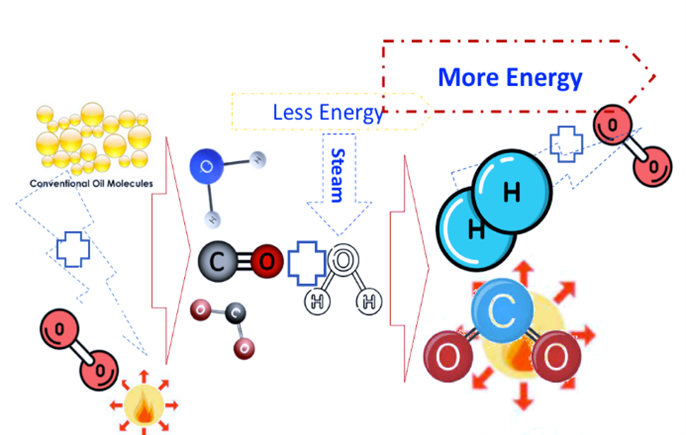Optimizing energy harvesting from waste motor oil through steam reforming: A path to efficient combustion and emissions reduction
Main Article Content
Abstract
Waste Motor Oil (WMO) is a hazardous waste material with the potential to contaminate water, soil, and the atmosphere. The management and engineering of WMO have become imperative in modern society for both resource utilization and environmental protection. Maximizing the energy content of WMO poses a significant challenge for researchers, to solve environmentally friendly solutions. Direct combustion of WMO often results in incomplete combustion and elevated CO emissions. Therefore, this research aims to optimize the harnessing of WMO's energy potential through a furnace equipped with steam injection. The steam is generated by utilizing the heat energy produced during the WMO heating process. Our study demonstrates that steam injection in the WMO furnace is an effective method for maximizing energy content while simultaneously reducing CO emissions.
Downloads
Article Details

This work is licensed under a Creative Commons Attribution-NonCommercial 4.0 International License.
References
[2] M. Setiyo, “Alternative fuels for transportation sector in Indonesia,” Mechanical Engineering for Society and Industry, vol. 2, no. 1, pp. 1–6, 2022, doi: https://doi.org/10.31603/mesi.6850.
[3] R. M. Susanto and M. Setiyo, “Natural Gas Vehicle (NGV): Status Teknologi dan Peluang Pengembangannya,” Automotive Experiences, vol. 1, no. 01, pp. 1–6, 2018, doi: https://doi.org/10.31603/ae.v1i01.2000.
[4] S. Vellaiyan and K. S. Amirthagadeswaran, “Compatibility test in a CI engine using lemon peel oil and water emulsion as fuel,” Fuel, vol. 279, no. June, p. 118520, 2020, doi: https://doi.org/10.1016/j.fuel.2020.118520.
[5] T. Kivevele, T. Raja, V. Pirouzfar, B. Waluyo, and M. Setiyo, “LPG-Fueled Vehicles: An Overview of Technology and Market Trend,” Automotive Experiences, vol. 3, no. 1, pp. 6–19, 2020, doi: https://doi.org/10.31603/ae.v3i1.3334.
[6] B. Waluyo, I. N. G. Wardana, L. Yuliati, M. N. Sasongko, and M. Setiyo, “The role of polar ethanol induction in various iso-octane ethanol fuel blend during single droplet combustion,” Fuel Processing Technology, vol. 199, p. 106275, 2020, doi: https://doi.org/10.1016/j.fuproc.2019.106275.
[7] A. Kolakoti, M. Setiyo, and B. Waluyo, “Biodiesel Production from Waste Cooking Oil: Characterization, Modeling and Optimization,” Mechanical Engineering for Society and Industry, vol. 1, no. 1, pp. 22–30, 2021, doi: https://doi.org/10.31603/mesi.5320.
[8] S. S. Lam, A. D. Russell, C. L. Lee, S. K. Lam, and H. A. Chase, “Production of hydrogen and light hydrocarbons as a potential gaseous fuel from microwave-heated pyrolysis of waste automotive engine oil,” International Journal of Hydrogen Energy, vol. 37, no. 6, pp. 5011–5021, 2012, doi: https://doi.org/10.1016/j.ijhydene.2011.12.016.
[9] Z. Yang et al., “Composition characteristics of siloxane derived waste lubricating oil and its effect on low-rank coal flotation,” Fuel, vol. 305, no. April, p. 121555, 2021, doi: https://doi.org/10.1016/j.fuel.2021.121555.
[10] M. Setiyo, “Waste motor oil (WMO): Between environmental challenges and economic opportunities,” 2023. https://muji.blog.unimma.ac.id/waste-motor-oil-wmo-between-environmental-challenges-and-economic-opportunities/ (accessed Dec. 08, 2023).
[11] R. Vazquez-Duhalt, “Environmental impact of used motor oil,” The Science of the Total Environment, vol. 79, pp. 1–23, 1989, doi: https://doi.org/10.1016/0048-9697(89)90049-1.
[12] S. Widodo, D. Ariono, K. Khoiruddin, A. N. Hakim, and I. G. Wenten, “Recent advances in waste lube oils processing technologies,” Environmental Progress and Sustainable Energy, vol. 37, no. 6, pp. 1867–1881, 2018, doi: https://doi.org/10.1002/ep.13011.
[13] W. Pimda and S. Bunnag, “Biodegradation of waste motor oil by Nostoc hatei strain TISTR 8405 in water containing heavy metals and nutrients as co-contaminants,” Journal of Industrial and Engineering Chemistry, vol. 28, pp. 117–123, 2015, doi: https://doi.org/10.1016/j.jiec.2015.02.006.
[14] S. Uçar, A. R. Özkan, and S. Karagöz, “Co-pyrolysis of waste polyolefins with waste motor oil,” Journal of Analytical and Applied Pyrolysis, vol. 119, pp. 233–241, 2016, doi: https://doi.org/10.1016/j.jaap.2016.01.013.
[15] H. Shabanzade, A. Salem, and S. Salem, “Management of adsorbent content in waste motor oil regeneration by spectrophotometrical study and effective acidification in production of nano-porous clay,” Spectrochimica Acta - Part A: Molecular and Biomolecular Spectroscopy, vol. 202, pp. 214–221, 2018, doi: https://doi.org/10.1016/j.saa.2018.05.056.
[16] N. Anwar et al., “Recycling of Automotive Lubricating Waste Oil and Its Quality Assessment for Environment-Friendly Use,” Research Journal of Environmental and Earth Sciences, vol. 4, no. 10, pp. 912–916, 2012.
[17] S. S. Lam, A. D. Russell, C. L. Lee, and H. A. Chase, “Microwave-heated pyrolysis of waste automotive engine oil: Influence of operation parameters on the yield, composition, and fuel properties of pyrolysis oil,” Fuel, vol. 92, no. 1, pp. 327–339, 2012, doi: https://doi.org/10.1016/j.fuel.2011.07.027.
[18] S. S. Lam, A. D. Russell, and H. A. Chase, “Microwave pyrolysis, a novel process for recycling waste automotive engine oil,” Energy, vol. 35, no. 7, pp. 2985–2991, 2010, doi: https://doi.org/10.1016/j.energy.2010.03.033.
[19] Z. Yang, Y. Liao, H. Ren, X. Hao, X. Song, and Z. Liu, “A novel co-treatment scheme for waste motor oil and low rank coal slime: Waste dispose waste,” Fuel, vol. 292, no. September 2020, p. 120275, 2021, doi: https://doi.org/10.1016/j.fuel.2021.120275.
[20] U. Phusuwan, D. Atong, J. Nisamaneenate, and V. Sricharoenchaikul, “Sustainable fuel production from steam reforming of waste motor oil over olivine-supported Fe catalyst,” Energy Reports, vol. 7, no. May, pp. 579–590, 2021, doi: https://doi.org/10.1016/j.egyr.2021.07.095.
[21] A. Mishra and B. C. Meikap, “Optimization of process parameters for waste motor oil pyrolysis towards sustainable waste-to-energy utilizing a combinatorial approach of response surface methodology and desirability criteria,” Fuel, vol. 353, no. June, p. 129226, 2023, doi: https://doi.org/10.1016/j.fuel.2023.129226.
[22] Y. Rodriguez et al., “Kinetic study of the catalytic cracking of waste motor oil using biomass-derived heterogeneous catalysts,” Waste Management, vol. 167, no. May, pp. 46–54, 2023, doi: https://doi.org/10.1016/j.wasman.2023.05.027.
[23] P. Sharma et al., “Biotransformation of food waste into biogas and hydrogen fuel – A review,” International Journal of Hydrogen Energy, 2022, doi: https://doi.org/10.1016/j.ijhydene.2022.08.081.
[24] C. C. Chen, H. H. Tseng, Y. L. Lin, and W. H. Chen, “Hydrogen production and carbon dioxide enrichment from ethanol steam reforming followed by water gas shift reaction,” Journal of Cleaner Production, vol. 162, pp. 1430–1441, 2017, doi: https://doi.org/10.1016/j.jclepro.2017.06.149.
[25] I. M. Rasta, I. N. G. Wardana, N. Hamidi, and M. N. Sasongko, “The Role of Soya Oil Ester in Water-Based PCM for Low Temperature Cool Energy Storage,” Journal of Thermodynamics, vol. 2016, 2016, doi: https://doi.org/10.1155/2016/5384640.

